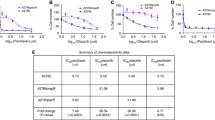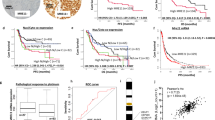Abstract
We have recently demonstrated that overexpression of dihydrodiol dehydrogenase (DDH) in human ovarian carcinoma cells (2008/C13*) is associated with cisplatin and carboplatin resistance. Furthermore, we have also elucidated that transfection of parental human ovarian carcinoma cells with a full-length DDH1 cDNA leads to induction of resistance to the platinum drugs. The development of cisplatin resistance in the transfected cells is associated with an increase in DDH enzyme activity. Previous studies have identified several different mechanisms for development of cisplatin resistance, including altered DNA repair capacity, increased GSH-based detoxification, and increased metallothionein content. However, none of these mechanisms has been found to be universally associated with the development of cisplatin resistance in tumor cells from different tissue sources. The present study was undertaken to assess whether overexpression of DDH1 or DDH2 (in human ovarian, cervical, lung and germ-cell tumor cell lines) could specifically induce resistance to the platinum drugs in these cell lines. We demonstrated a ubiquitous association of increased expression of DDH1 or DDH2 (as judged by increased enzyme activity in transfected clones) with development of resistance to cisplatin and carboplatin. Moreover, we also found a lack of cross-resistance to anticancer drugs that have a different mode of action including paclitaxel, vincristine, doxorubicin hydrochloride, and melphalan. Although at present it is not clear how DDH is involved in platinum drug resistance, the identification of this gene as a causal factor in a series of cell lines derived from different tumors with different intracellular compositions indicates the importance of deciphering this hitherto undefined pathway which can produce resistance to platinum drugs.
Similar content being viewed by others
Abbreviations
- ARE:
-
Antioxidant response element
- Cisplatin:
-
cis-Diamminedichloroplatinum
- DDH:
-
Dihydrodiol dehydrogenase
- GST:
-
Glutathione S-transferase
- MRP:
-
Multiple drug resistance-associated protein
References
Andrews PA, Albright KD (1992) Cancer Res 52:1895–1901
Andrews PA, Velury S, Mann SC, Howell SB (1988) Cancer Res 48:68–73
Ax W, Soldan M, Koch L, Master E (2000) Biochem Pharmacol 59:293–300
Burczynski ME, Harvey RG, Penning TM (1988) Biochemistry 37:6781–6790
Chatterjee D, Liu CJ, Northey D, Teicher BA (1995) Cancer Chemother Pharmacol 35:423–431
Christen RJ, Jekunen AP, Jones JA, Thiebaut F, Shalinsky DR, Howell SB (1993) J Clin Invest 92:431–440
Chung YM, Yoo YD, Park JK, Kim Y-T, Kim HJ (2001) Anticancer Res 21:1129–1134
Ciaccio PJ, Stuart JE, Tew KD (1993) Mol Pharmacol 43:845–853
Ciaccio PJ, Jaiswal AK, Tew KD (1994) J Biol Chem 269:15558–15562
Dempke W, Volgt W, Grothey A, Hill BT, Schmoll HJ (2000) Anti-Cancer Drugs 11:225–236
Deng HB, Parekh HK, Chow K-C, Simpkins H (2002) J Biol Chem 277:15035–15043
Hsu NY, Ho HC, Chow KC, Lin TY, Shih CS, Wang LS, Tsai CM (2001) Cancer Res 61:2727–2731
Isonishi S, Jekunen AP, Hom DH, Eastman A, Edelstein PS, Thiebaut FB, Christen RD, Howell SB (1992) J Clin Invest 90:1436–1442
Kasahara K, Fujiwara Y, Nishio K, Ohmori T, Sugimoto Y, Komiya K, Matsuda T, Saijo N (1991) Cancer Res 51:3237–3242
Kelly SL, Basu A, Teicher BA, Hacker MP, Hamer DH, Lazo JS (1988) Science 241:1813–1815
Lai GM, Ozols RF, Young RC, Hamilton TC (1988) Biochem Pharmacol 37:4597–4600
Loehrer PJ, Einhorn LH (1984) Ann Intern Med 100:704–713
Loh SY, Mistry P, Kelland LR, Abel G, Harrap KR (1992) Br J Cancer 66:1109–1115
Mamenta EL, Poma EE, Kaufmann WK, Delmastro DA, Grady HL, Chaney SG (1994) Cancer Res 54:3500–3505
Mann SC, Andrews PA, Howell SB (1991) Int J Cancer 48:866–872
Marth C, Widschwendter M, Kaern J, Jurgensen NP, Windbichler G, Zeimet AG, Trop C, Daxenbichler G (1997) Br J Cancer 76:1328–1332
Masuda SC, Ozols RF, Lai GM, Fojo A, Rothenberg M, Hamilton TC (1988) Cancer Res 48:5713–5716
Meijer C, Mulder NH, Timmer-Bosscha H, Sluiter WJ, de Vries EGE (1992) Cancer Res 52:6885–6889
Miyake H, Hanada N, Nakamura H, Kagawa S, Fujiwara T, Hara I, Eto H, Gohji K, Arakawa S, Kamidono S, Saya H (1998) Oncogene 16:933–943
Moorehead RA, Singh G (2000) Biochem Pharmacol 59:337–345
Parekh HK, Simpkins H (1995) Cancer Res 55:5203–5206
Parekh HK, Simpkins H (1996) Cancer Chemother Pharmacol 37:457–462
Pinto A, Lippard SJ (1985) Biochim Biophys Acta 780:167–180
Smithgall TE, Harvey RG, Penning TM (1986) J Biol Chem 261:6184–6191
Smithgall TE, Harvey RG, Penning TM (1988) Cancer Res 48:1227–1232
Smithgall TE, Harvey RG, Penning TM (1988) J Biol Chem 263:1814–1820
Timmer-Bosscha H, Mulder NH, de Vries EGE (1992) Br J Cancer 66:227–238
Acknowledgements
This research was supported by NIH Grant CA98804 to H.S.
Author information
Authors and Affiliations
Corresponding author
Rights and permissions
About this article
Cite this article
Deng, H.B., Adikari, M., Parekh, H.K. et al. Ubiquitous induction of resistance to platinum drugs in human ovarian, cervical, germ-cell and lung carcinoma tumor cells overexpressing isoforms 1 and 2 of dihydrodiol dehydrogenase. Cancer Chemother Pharmacol 54, 301–307 (2004). https://doi.org/10.1007/s00280-004-0815-0
Received:
Accepted:
Published:
Issue Date:
DOI: https://doi.org/10.1007/s00280-004-0815-0




